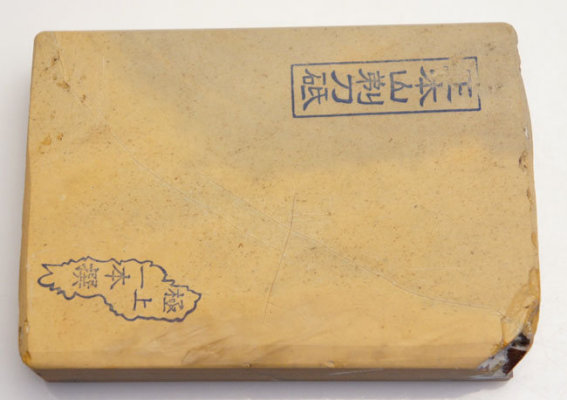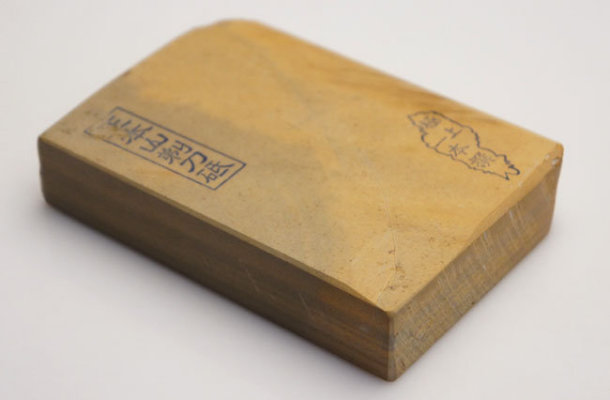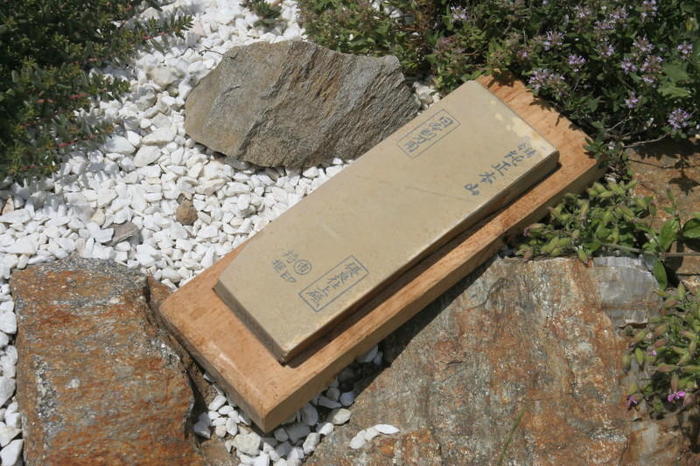Results 1 to 10 of 11
Hybrid View
-
08-18-2012, 02:35 AM #1Junior Member

- Join Date
- Dec 2011
- Posts
- 16
Thanked: 5 Mystery Stone: Maruka Nakayama Kiita Nashiji
Mystery Stone: Maruka Nakayama Kiita Nashiji
I finally bit the bullet and bought a Japanese natural stone in January. It was marketed as a Maruka Nakayama Kiita. It was purported to be an old stock from a Barber and friend of Iwasaki. It was locked with other stones, and reportedly "it is good old days very high quality Nakayama Maruka which is very hard to come by nowadays." He mentioned it was very smooth with fine particles, and honed well.
It was a steal for a Maruka and also of the legendary Kiita color, so I asked for help translating. With some hesitation I bought it. I am glad i did.
For those who might run into these types, I will add what I hope to be useful info. The upper kanji are the marks distinguishing the hone. In the upper left, the top three characters read Sho ( 正 ) Hon ( 本 ) Zan ( 山 ). This could be read differently, but I was assured Sho-Hon-Zan was the correct reading. This means "True mountain" according to Jim Rion's site, or "True Original Mountain" according to my japanese friend - but, she cautioned, "this doesn't mean anything, it is just the name of the mountain - like Main Street". This is a desirable mountain for hones, and it is the same mountain that contains the Nakayama mine. If this is a Kiita from that mountain, I was probably going to have a good quality hone. The bottom three kanji (剃 刀 砥) mean basically "Razor Hone". The first two (剃刀) mean kamisori, or razor, and the last (砥) I assume mean hone - she didn't know the exact english word for this, and thus couldn't translate. She instead looked at me blankly and made honing motions with her hands.
Many stones of varying character mined from this mountain, and some are fast, rough cutters, and some are very hard polishers. The "Razor Hone" kanji I assume meant that this stone was suitable for "Kamisori" or Razors. So this entire Kanji group reads "Razor Hone mined from the ShoHonZan mountain".
The lower leaf kanji are then marks of quality - two in fact. The two top right ( 極上 ) means "Premium", the lower three ( 一本撰 ) mean first or top quality.
I was told these stamps are the marks of testing - meaning the stone was tested and graded, and the stamps meant it passed those standards. As a side note, she mentioned that the language was unusual, and that they should have used hiragana in place of the lowest kanji. She took this to mean it was a marketing play "to make it cool". This does not mean it is not true, however, just that they used more of a marketing type lingo here.


So I was left with some detective work when it arrived. There was no Maruka circle stamp, which means if it was a Maruka, the stamp on the sides wore off. It could also have been a stone that Maruka passed on to others to sell. When Maruka mined, he would only add his name to the finest stones and sell them for a premium. Those with some defect or another would be passed off to others to be sold by wholesalers. The stone also appeared to have been sawn in half, with a rough saw mark on one side. It is now the hand size you see many japanese barbers hone with. It could have been circle marked, but that side cut off to make two hones. I asked the vendor about this, and he wrote that it was a very reputable source, and that he thought it had been sawn in half with the other half, that had the mark on it, sold for much more money. No one knows for sure.
Also, it is not known if this stone was in fact mined from the Nakayama mine. It might have been, or it could have been mined from next door - though the same strata. The very knowledgable user alx posted good info here on the authenticity of Nakayama stones. This stone posses the SHoHonZan kanji, but the "kamisori hone" kanji is different than what he has linked to. Perhaps he can shed some light on this.
All that I was certain of is that this was in fact a Kiita Nashiji. These refer to the color. The Kiita refers to the yellow color, a much sought after stone for its cutting qualities. The Nashiji is an asian pear, which you might see in your local grocery store. It is quite delicious, but with stones the Nashiji refers to its specks. This supposedly causes it to have a faster cutting power, but that is debatable.
Next up was to use it and see the quality first hand. I'll post more on this process.Last edited by stmaiku; 08-18-2012 at 02:55 AM. Reason: typos :)
-
08-18-2012, 03:30 AM #2At this point in time...




- Join Date
- Jun 2007
- Location
- North Idaho Redoubt
- Posts
- 27,161
- Blog Entries
- 1
Thanked: 13249
This is one that I got sometime back, I guess the name actually goes in a different order
 heck all I know is that it works
heck all I know is that it works 
Nakayama Tomae Midori Nashiji
http://straightrazorpalace.com/hones...-nakayama.html
The specks on your Kitta are much easier to see
-
08-18-2012, 03:35 AM #3

When you hone on it .... if it delivers the goods in a big way you'll be less concerned about the kanji. Hope it is a winner for you.

-
08-18-2012, 03:42 AM #4Junior Member

- Join Date
- Dec 2011
- Posts
- 16
Thanked: 5
wow gssixgun that is a beautiful stone!
-
08-18-2012, 03:32 AM #5I used Nakayamas for my house



- Join Date
- Aug 2009
- Location
- Des Moines
- Posts
- 8,664
- Blog Entries
- 1
Thanked: 2591
The side stamp does not wear off so easy.
Those stones are not real marukas , you can find them on Japanese auctions a lot of them and they are not expensive. Some stones have the maruka stamp right on top of the hone too, not the side where it supposed to be, makes me doubt authenticity even more.
The story about the barber that was friend with Iwasaki has been going on for ~ 2 years now, and I do not think it is sellers fault its what he was told by those that put the stamps on the stones. Right now razor sized Kiita colored Nkayamas (if you can find them ) go for some real crazy prices think in the order 400+ USD, there is some kind of hype going on with kiita stones in Japan that ups the prices a lot. All that being said if the stone works nothing else matters.Last edited by mainaman; 08-18-2012 at 03:37 AM.
-
08-18-2012, 03:54 AM #6Junior Member

- Join Date
- Dec 2011
- Posts
- 16
Thanked: 5
-
08-18-2012, 04:39 AM #7I used Nakayamas for my house



- Join Date
- Aug 2009
- Location
- Des Moines
- Posts
- 8,664
- Blog Entries
- 1
Thanked: 2591
-
08-18-2012, 06:57 PM #8Junior Member

- Join Date
- Dec 2011
- Posts
- 16
Thanked: 5
I have been discussing my experiences with an elderly japanese man, and watched some of Glen's vids on honing a kamisori, and thought I should add some thoughts to clarify. It seems that my fortune is a result of my stone and the nature of the kamisori. I would not be able to reproduce this with a western razor, for sure. I was able to get the great results from this stone (bevel to finish on one stone, and quickly) because it was a kamisori and a good Kiita. Because of the way the kamisori is shaped and composed, one is able to apply and control much greater spans of pressure than one could with a western straight. Also, this type of razor allows a great deal of control when honing, and sharpens very well (some say easily). I pressure sharpen like a sashimi knife, with my fingers on the blade (although facing me). As I work, I lighten the pressure. To finish, I use only one hand and very very light pressure like most others.
I have always strived for a minimalist setup, with one razor (or two ), and one stone. I am happy to report I am able to do this. Again, though, I don't think this can be done with anything other than a kamisori style razor (although some of the more skilled people here might..?). Thanks to all the geniuses who are on this site, though - it is a tremendous resource for learning.
), and one stone. I am happy to report I am able to do this. Again, though, I don't think this can be done with anything other than a kamisori style razor (although some of the more skilled people here might..?). Thanks to all the geniuses who are on this site, though - it is a tremendous resource for learning.
Last edited by stmaiku; 08-19-2012 at 02:52 AM. Reason: whoops
-
08-26-2012, 02:48 PM #9

here is my real Nakayama with all cancels....of a colleague, but 350 Euro.....it is the best Stone...

-
08-26-2012, 06:08 PM #10At this point in time...




- Join Date
- Jun 2007
- Location
- North Idaho Redoubt
- Posts
- 27,161
- Blog Entries
- 1
Thanked: 13249
I have come to believe whether right or wrong, that to get the most out of many Japanese finishers the slurry has to be worked, ie: crushed and smashed into a fine powder
Kamisori style honing, with the pressure fluctuations on the edge does this by it's very nature, Western style razors and the honing we do with them does not..
Some people save the slurry on the stone and continue to use it, which is one way around this, but makes your stone very limited for use, I also think that the slow break down of the slurry is what creates the beautiful haze bevel finish and eventually the final break down gets the mirror at the very edge...
I have been using that Pigtail stoke for breaking down the slurry when honing Western razors on the Nakayama, then slowly working to a point where I can get almost the same effect of the haze -to- mirror as I can on the Kamisori, it is not as smooth a progression as the Kamisori style honing produces naturally, and takes much more time and patience, but it can work...
This is what I gave found works on my stone, doesn't mean it will work on yours, but it could be a starting point for you anyway...


 8Likes
8Likes LinkBack URL
LinkBack URL About LinkBacks
About LinkBacks






 Reply With Quote
Reply With Quote


